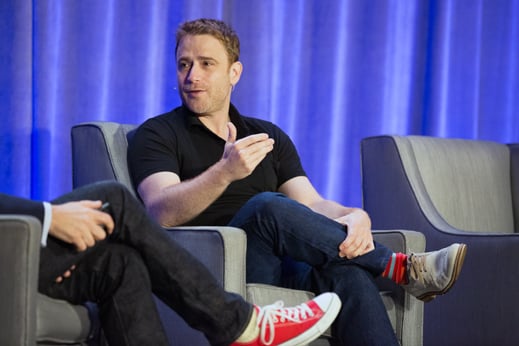EmTech Digital: Work Chat App Slack Wants You to Message with Machines
Fast-rising workplace chat service Slack wants you to send messages to more than just people. The company is working to help companies use Slack messages to take control of their internal software such as sales, HR, or document-tracking tools.

Being able to send chat messages to software makes it easier to get work done because you can operate key tools without having to leave the application you use to let coworkers know what you’re doing, said Slack CEO Stewart Butterfield at MIT Technology Review’s EmTech Digital event in San Francisco Tuesday.
For example, Slack employees can send a message starting with a “/” to quickly create a new entry in the company’s bug tracking software, and include the names of other people that need to know about it. The software sends a message back to all the people included with a message of its own containing a link to the new entry.
“That has saved people a lot of time,” said Butterfield. The same concept can be applied to all kinds of workplace software, he said. “Every company has a handful or many dozens of different internal services it uses from accounting to CRM, business analytics, [or] customer support ticketing,” he said.
Butterfield’s vision for people using Slack to collaborate with both people and machines would see his company become much more than just a communication tool. It would bring it into closer competition with productivity tools from established companies such as Microsoft and IBM, and newer challengers such as Box and Dropbox (see “Dropbox Follows the Money Into Crowded Market for Collaboration Tools”). Butterfield has said frequently that the Slack service as it exists today is a long way short of what he hopes to offer companies (see “Three Questions with Slack’s CEO”).
Slack has made extensive use of the integration feature. Butterfield cited that as a preview of how other companies should come to use his product. “We do about 10,000 to 15,000 messages a day from human beings and another 50,000 to 80,000 a day from machines,” said Butterfield.
It has been possible for companies to integrate other software with Slack since it launched. But Butterfield said that awareness and take-up of that functionality has been small so far. “We have not done a great job in showing how easy it is for people to integrate their own internal systems,” he said. Slack is now working to change that, he said.
Keep Reading
Most Popular
Large language models can do jaw-dropping things. But nobody knows exactly why.
And that's a problem. Figuring it out is one of the biggest scientific puzzles of our time and a crucial step towards controlling more powerful future models.
How scientists traced a mysterious covid case back to six toilets
When wastewater surveillance turns into a hunt for a single infected individual, the ethics get tricky.
The problem with plug-in hybrids? Their drivers.
Plug-in hybrids are often sold as a transition to EVs, but new data from Europe shows we’re still underestimating the emissions they produce.
Google DeepMind’s new generative model makes Super Mario–like games from scratch
Genie learns how to control games by watching hours and hours of video. It could help train next-gen robots too.
Stay connected
Get the latest updates from
MIT Technology Review
Discover special offers, top stories, upcoming events, and more.